CAMP PERRY, OHIO – The ranges at Camp Perry are THE place shooting competitors come to win championships. And over the years, many very skilled shooters have graced the ranges and awards podium, leaving with hard-earned medals, plaques, badges and trophies.
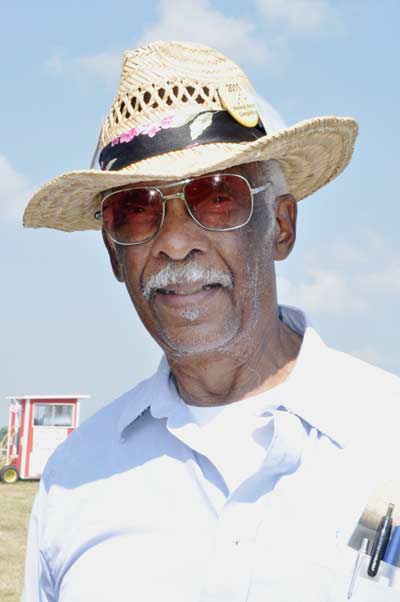
|
|
Bill Bumpus beat the Camp Perry sun in his trademark straw hat and blue jacket during the National Trophy Individual Pistol Match on Sunday, 17 July.
|
For many others it’s a place where family and friends come together to enjoy their summer vacations, combining shooting with family reunions and reacquainting with old friends and taking in the aura and atmosphere of the grand-daddy of all shooting events.
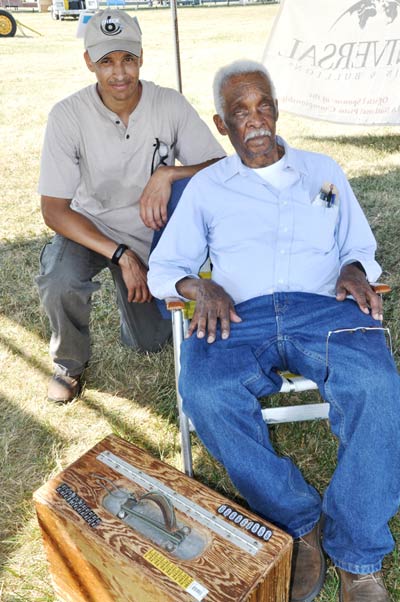
|
|
LTC Michael W. Bumpus, left, joins his dad Bill Bumpus under the canopy on Rodriguez Range. Bill was particularly proud to display his homemade gun box which he built in 1958 and still serves his needs. The wooden box features 45-degree-angled aluminum pistol racks covered in deerskin to protect his pistols.
|
When Bill Bumpus and his son, LTC Michael W. Bumpus, arrived to participate in the President’s Pistol Trophy and National Individual Trophy matches, they had no intention of winning championships, and neither did. Bill didn’t score particularly well and Mike finished somewhere in the middle of the pack.
But it didn’t matter, because when the shooting was done, they had gotten what they came for – a taste of the Camp Perry experience – one that Bill had thick memories of from years past.
They climbed into their motor home and headed back to South Carolina with less ammunition, too much sun and more father and son memories to add to their rich and still-growing scrapbook.
Bill said his shooting hand quivers a bit and he’ll tell you the reason is the heart medication he’s on.
“When we get back I’m going to ask my doctor to prescribe something that takes away some of this shakiness,” he said. “There’s not much web left in this hand,” he added, pointing to the “V” between thumb and forefinger. After all, it’s been taking a pounding since he first started shooting a .45 competitively in 1958.
Of course at age 83, just standing at a shooting bench for two pistol matches under the unyielding Camp Perry sun, pointing a Model 1911 in the general direction of the target is still a pretty demanding task.
Two of Bill’s most memorable shooting achievements over the years were his first Air Force team match at Camp Perry in 1960 and seven years later firing a 280-4X, just missing the President’s Hundred cut as an individual shooter.
As he recounted his many memories as a pistol shooter, competing at many ranges across the country and here at Camp Perry, Bill explained how the field of aviation and the military opened many doors from childhood until now.
It was during the Great Depression that Bill found his future in aviation. His father’s work in the coal mines dwindled and the family moved to Toledo, Ohio to find work and to be near family. He grew up in the Toledo area and started flying at 13 when he worked as a line boy performing maintenance at a local aeronautical school.
“My fingers were too short to play the piano or to type, so I had to find something else to do,” he said jokingly.
His flying school boss took a liking to him and asked him if he’d like to learn to fly. Bill took him up on the offer and it all seemed logical – he could learn a lot more about aircraft maintenance if he actually knew how airplanes functioned. He had a pilot’s license long before a driver’s license, he said.
Back in those days a lot of planes didn’t have automatic starters, so we had to prop ‘em” from behind,” (manually turn the propeller) he said.
That very basic, humble beginning as a young teen led to a 55-year career as a pilot, logging more than 20,000 flight hours in Air Force and commercial aircraft. He enlisted in the Air Force in 1948 and was assigned to Randolph Field (now Randolph AF Base) near San Antonio, Texas, the home of Air Force instruction and forerunner of the U.S. Air Force Academy (now in Colorado Springs).
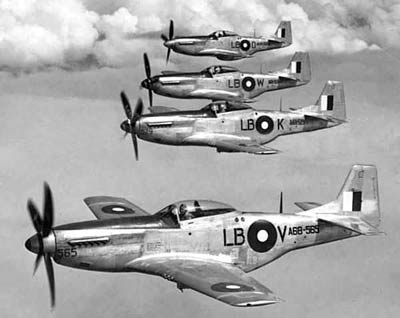
|
|
Bumpus flew P-51 Mustangs in the early 1950s and served as an advisor with the Korean Air Force with a Korean P-51 squadron.
|
Bumpus flew P-51 Mustangs, first as an American fighter pilot in the Korean War and later as an advisor to the Korean Air Force in the early 1950s. While in the Air Force he also flew bombers and transports including the B-25, B-26, B-17, B-29, C-97, B-50 and more.
He began competitive shooting in the Air Force in 1958 and did some shotgun shooting as part of his aircraft shooting instruction, he said. “We used to get to shoot skeet and stuff to get the lead-pursuit concept.” He said all pilots had to stay qualified with the .45 pistol which was their survival weapon in the event of trouble so he remained proficient in its use.
“It was at Eglin Air Force Base when this old guy saw me knocking a hole in the middle of a target. He said ‘You’re going to be on the pistol team.’”
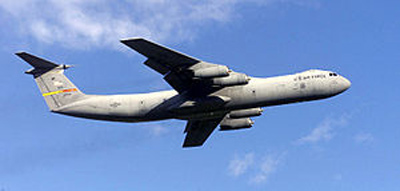
|
|
Logging more than 3,000 hours in the big C-141 Starlifter, Bumpus flew transports in the U.S. and overseas during his Air Force career.
|
Bill obliged. Throughout the 1960s he fired in as many matches as he could, making occasional trips to Camp Perry. By 1970 he had logged 10,000 hours of flying time, including 3,000 hours in a Lockheed C141 Starlifter four-engine heavy-lift transport jet. Commercially he flew Boeing 707s and eventually 747s.
His flight experience combined with his innate mechanical sense then led him into a world of aviation very few experience. He became a check pilot, testing systems and flight simulators. Bill’s career in aviation culminated as aviation crash site investigator. Originally assigned to work with TWA, Pan AM and Atlas Airlines, he put all of his aviation and mechanical aptitude to work assisting with the physical examination of several major airline crash sites helping law enforcement and government agencies explain the nature of plane crashes.
It’s common for investigators to be assigned to specific airlines so they can immerse themselves in that company’s specific policies and procedures. When crashes occur it makes it easier for investigators to understand why pilots and crew respond the way they do during unexpected events, he said.
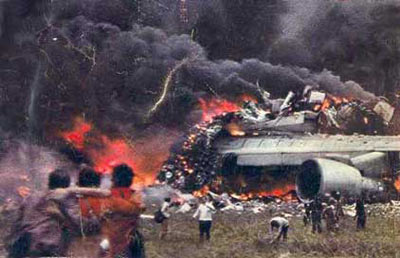
|
|
Now a crash investigator, Bumpus had the grueling task of helping to sort out just what happened when a KLM Airlines 747 collided on take-off with a Pan Am 747 on Tenerife Island in 1977.
|
His assignments included some of the notable events in aviation history including the 1977 collision between a Pan Am jet and a KLM airliner that took 583 lives on Tenerife, the largest of the Canary Islands. It was the deadliest aviation accident in history.
Bumpus was assigned to the terrorist downing of Pan Am Flight 103 over Lockerbie, Scotland in December 1988 - a Boeing 747 named Clipper Maid of the Seas that was destroyed by a bomb, killing all 243 passengers and 16 crew members plus 11 on the ground as large sections of the plane fell in the town and destroyed several houses, bringing total fatalities to 270.
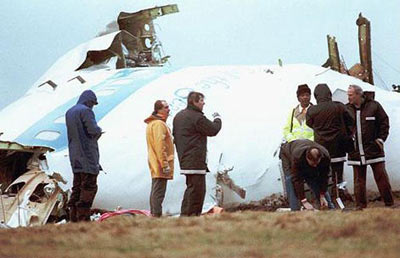
|
| As a Federal Aviation Administration
crash investigator, Bumpus (pictured standing third from
right) covered miles of Scottish farmland looking for
clues that would help lead to the explanation of the
destruction of Pan Am Flight 103 in 1988. |
Bumpus said he was deputized by both the FBI and Scottish police to gain access to the crash site.
“I was tracking through the Scottish fields picking up pieces of wreckage,” he said. It was Bumpus’ job to help find clues that would one day prove the crash was a criminal act.
“It wasn’t easy, but it’s a part of the job,” Bill said as he described combing through pieces of aircraft, luggage and human remains in search of evidence. When the investigation was complete, authorities found traces of explosives, a detonating device and other articles that were traced to Libyan terrorists. Years later the Libyan government admitted complicity in the bombing.
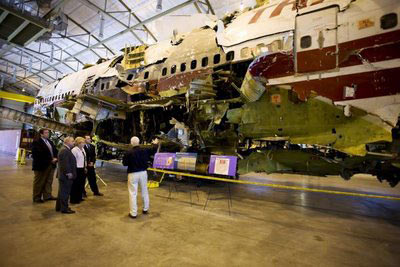
|
|
The majority of the fuselage of TWA Flight 800 was retrieved in pieces from the bottom of the Atlantic Ocean off Long Island in 1996 and reassembled in a hangar to help investigators determine the cause of an explosion that sent the airliner plunging into the ocean.
|
Bumpus served on the crash investigation team of TWA Flight 800 off New York City’s Long Island in 1996. The Boeing 747 was flying to Paris from New York's JFK International Airport and plunged into the ocean after a catastrophic break-up shortly after take-off. None of the 230 people aboard survived. A spark or unusual heat source in the plane’s near-empty center fuel tank was ruled the cause of the accident.
Bill’s son Mike, also a pilot and full-time member of the Louisiana Air National Guard, is a graduate of the U.S. Air Force Academy, having received his commission in 1986. He is one of seven children, four of which have attended the Academy.
Mike began shooting competitively in rifle and pistol with his high school shooting club. He and his dad have shot pistol together at Fort Benning and this year at Camp Perry. He served as an Air Force pilot seeing action over Bosnia; returned to civilian life as a first officer for United Airlines and when the company cut back he returned to the military and flew A-10 Warthogs over Afghanistan.
Mike began shooting competitively in rifle and pistol with his high school shooting club. He and his dad have shot pistol together at Fort Benning and this year at Camp Perry. He served as an Air Force pilot seeing action over Bosnia; returned to civilian life as a first officer for United Airlines and when the company cut back he returned to the military and flew A-10 Warthogs over Afghanistan.
The elder Bumpus, now residing in Charleston, South Carolina, retired in April 2003, having served the last 34 years of his career as investigator. He was an active pilot until turning in his wings at age 75. At least now he has more time to dedicate to family and one of his favorite passions – just being dad.
For complete results of the 2011 National Trophy Pistol Matches, log onto
http://clubs.odcmp.com/cgi-bin/report_matchResult.cgi?matchID=6543. To view photos from the pistol matches, log onto
http://cmp1.zenfolio.com.
NEXT ARTICLE
|



